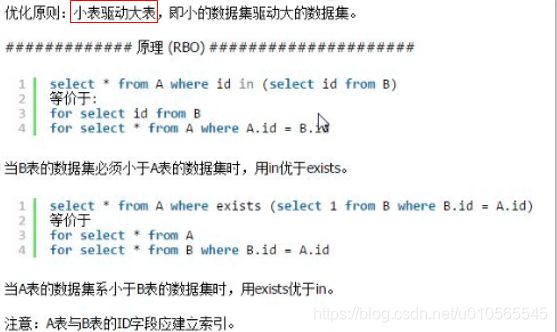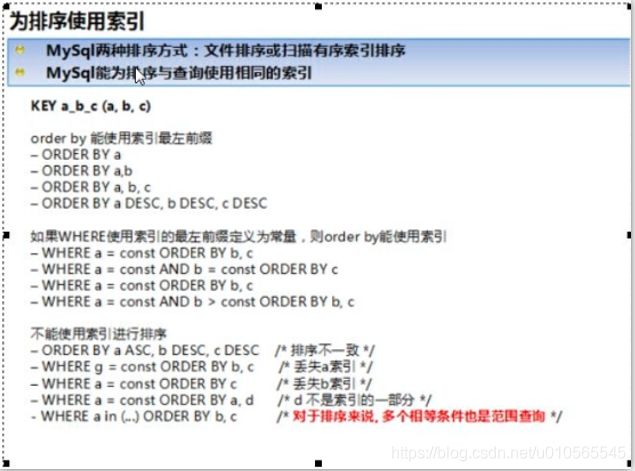常见的SQL面试题:经典50例
SQL基础知识整理
-
select 查询结果,如:
[学号,平均成绩:组函数avg(成绩)] -
from 从哪张表中查找数据,如:
[涉及到成绩:成绩表score] -
where 查询条件,如:
[b.课程号='0003' and b.成绩>80] -
group by 分组,如:
[每个学生的平均:按学号分组](oracle,SQL server中出现在select 子句后的非分组函数,必须出现在group by子句后出现),MySQL中可以不用 -
having 对分组结果指定条件,如:
[大于60分] -
order by 对查询结果排序,如:
[增序: 成绩 ASC / 降序: 成绩 DESC]; -
limit 使用limt子句返回topN(对应这个问题返回的成绩前两名),如:
[ limit 2 ==>从0索引开始读取2个]limit==>从0索引开始[0,N-1]
select * from table limit 2,1;
-- 含义是跳过2条取出1条数据,limit后面是从第2条开始读,读取1条信息,即读取第3条数据
select * from table limit 2 offset 1;
-- 含义是从第1条(不包括)数据开始取出2条数据,limit后面跟的是2条数据,offset后面是从第1条开始读取,即读取第2,3条
组函数: 去重 distinct() 统计总数sum() 计算个数count() 平均数avg() 最大值max() 最小数min()
多表连接: 内连接(省略默认inner) join ...on..左连接left join tableName as b on a.key ==b.key右连接right join 连接union(无重复(过滤去重))和union all(有重复[不过滤去重])
union 并集
union all(有重复)
oracle(SQL server)数据库
-
intersect 交集
-
minus(except) 相减(差集)
oracle
一、数据库对象:表(table) 视图(view) 序列(sequence) 索引(index) 同义词(synonym)
1. 视图: 存储起来的 select 语句
create view emp_vw
as
select employee_id, last_name, salary
from employees
where department_id = 90;
select * from emp_vw;
可以对简单视图进行 DML 操作
update emp_vw
set last_name = 'HelloKitty'
where employee_id = 100;
select * from employees
where employee_id = 100;
1). 复杂视图
create view emp_vw2
as
select department_id, avg(salary) avg_sal
from employees
group by department_id;
select * from emp_vw2;
复杂视图不能进行 DML 操作
update emp_vw2
set avg_sal = 10000
where department_id = 100;
2. 序列:用于生成一组有规律的数值。(通常用于为主键设置值)
create sequence emp_seq1
start with 1
increment by 1
maxvalue 10000
minvalue 1
cycle
nocache;
select emp_seq1.currval from dual;
select emp_seq1.nextval from dual;
问题:裂缝,原因:
-
当多个表共用同一个序列时。
-
rollback
-
发生异常
create table emp1(
id number(10),
name varchar2(30)
);
insert into emp1
values(emp_seq1.nextval, '张三');
select * from emp1;
3. 索引:提高查询效率
自动创建:Oracle 会为具有唯一约束(唯一约束,主键约束)的列,自动创建索引
create table emp2(
id number(10) primary key,
name varchar2(30)
)
手动创建
create index emp_idx
on emp2(name);
create index emp_idx2
on emp2(id, name);
4. 同义词
create synonym d1 for departments;
select * from d1;
5. 表:
DDL :数据定义语言 create table .../ drop table ... / rename ... to..../ truncate table.../alter table ...
DML : 数据操纵语言
insert into ... values ...
update ... set ... where ...
delete from ... where ...
【重要】
-
select ...组函数(MIN()/MAX()/SUM()/AVG()/COUNT()) -
from ...join ... on ...左外连接:left join ... on ... 右外连接: right join ... on ... -
where ... -
group by ...(oracle,SQL server中出现在select 子句后的非分组函数,必须出现在 group by子句后) -
having ...用于过滤 组函数 -
order by ...asc 升序, desc 降序 -
limit (0,4)限制N条数据 如: topN数据
union 并集
union all(有重复)
intersect 交集
minus 相减
DCL : 数据控制语言 commit : 提交 / rollback : 回滚 / 授权grant...to... /revoke
索引
何时创建索引:
一、
select employee_id, last_name, salary, department_id
from employees
where department_id in (70, 80) --> 70:1 80:34
-
union 并集
-
union all(有重复部分)
-
intersect 交集
-
minus 相减
select employee_id, last_name, salary, department_id
from employees
where department_id in (80, 90) --> 90:4 80:34
问题:查询工资大于149号员工工资的员工的信息
select *
from employees
where salary > (
select salary
from employees
where employee_id = 149
)
问题:查询与141号或174号员工的manager_id和department_id相同的其他员工的employee_id, manager_id, department_id
select employee_id, manager_id, department_id
from employees
where manager_id in (








